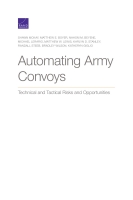by Shawn McKay
What are the potential risks of deploying AV technology in the Army over the next five years?
What effects will automated convoys have on Army force structure, operation planning, and execution?
This report examines how the U.S. Army can move ahead with the development and integration of automated driving technology for its convoy operations in the near future. Robotic ground vehicles are quickly maturing in the commercial sphere and could potentially save lives and increase efficiency if utilized in Army convoys. However, it may be many years until fully unmanned convoy vehicles are able to operate in rough terrain or manage adversarial attacks. In response, the authors of this report examine different employment concepts of automated trucks in Army convoys that appear viable in the next one to five years and would still reduce soldier casualties. The authors investigate technical and tactical benefits and risks of these concepts. A bridging option, the minimally manned employment concept, leading to the eventual use of a mix of manned and unmanned trucks in a convoy, is developed in this report to address the current technical and tactical risks of concepts requiring use of unmanned, automated trucks in Army convoys.
Key Findings
The partially unmanned employment concept still has risks; the minimally manned employment concept is a better option for now
The technology needed to put the partially unmanned (PU) employment concept (in which automated unmanned trucks follow the path of a manned truck in a convoy operation) into action might reach deployment readiness for highway driving in 2019, at the earliest. Full automation will take much longer.
The minimally manned (MM) employment concept (in which automated trucks, each containing a single soldier, follow a manned truck) is ready for Army adaptation and deployment in urban and highway environments. Moreover, a demonstration suggests that the technology can be developed for trail driving today. The human operator provides a level of redundancy and robustness required to compensate for the current shortcomings in automated technology.
Automated trucks will require convoy tasks, training, and organization structure to adapt
Soldiers who remain in the convoy could have higher cognitive loads as they perform additional tasks. Many of the affected tasks involve sensing and decisionmaking. In particular, the span of control might reduce for the convoy commander but might increase for the crews of lead vehicles that must manage unmanned following trucks.
Automated trucks will create greater demands for more-senior drivers and fewer demands for entry-level drivers. It is anticipated that this shift in personnel demand will change force structure requirements, training, and recruiting for convoy soldiers.
Recommendations
Execute the MM employment concept as a necessary bridging strategy to achieve the full PU employment capability. The driving environment in which automated Army trucks will operate is highly complex. Current automated technologies are sufficiently mature if there is a soldier within the vehicle monitoring the driving environment and regaining control in situations that the automated system is unable to handle. The MM employment concept allows the number of soldiers in the cab to be reduced from two to one, which maintains the primary motivation -- reducing soldier casualties. However, the employment of the automated truck technology with one soldier in the truck will be a major cultural adjustment for the Army.
Ensure that the human factors design is robust to mitigate employment risks inherent in the interim MM employment concept. The major technical drawback to the MM employment concept is the human factors design. There are relevant three design and training aspects: sensor perception communication, multimodal warning, and external communication. The success of employing automated truck technology under the MM employment concept is highly dependent on effective designs in these three areas.
Develop clear and practical technical requirements to reduce key development risks. The risks identified in this study (e.g., cyberattack) can be mitigated by managing them early in the development process.
Use the MM approach to collect sustained user input as a bridging strategy for PU development and refinement.
Prepare for the inevitable long-term force structure and personnel impacts resulting from automated technology emergence.

No comments:
Post a Comment